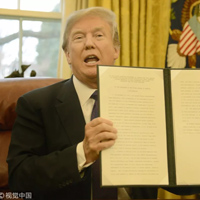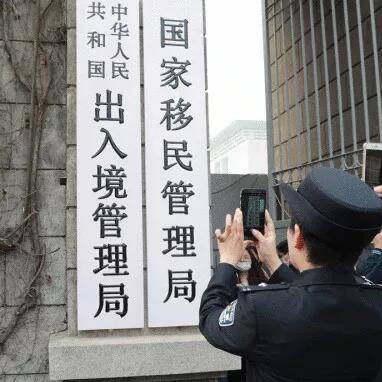- 当前位置:
- 首页>
- 活动>
- ���������������
���������������
CCG持续关注国际关系议题,推动中国与全球化的发展,积极开展国际交流,充分发挥智库“二轨外交”作用,在巴黎和平论坛、达沃斯世界经济论坛、慕尼黑安全会议等重要国际政策与意见交流平台上组织分论坛、边会、圆桌会议、晚宴等活动,促进国际政商学界对话,凝聚共识;CCG积极与各国政界、智库界、工商界开展“二轨外交”活动,每年常态化赴多国调研与交流,促进中外关系攸关方互动,保持与多国政策圈层的沟通渠道。
-

【China Daily】Looming US-China trade war is mere hype
Donald Trump’s stiff tariffs on Chinese imports have again refueled the concerns of a looming war, but we should refrain from blindly following this hype and approach the challenge in a rational way.Fears of a trade war between the world’s two largest economies still linger, with stocks on a roller coaster ride to a four-month low. The past week was brimming with high drama as the US president’s trade sanctions on China tumbled out and sparked a storm of backlash from the international community.The rhetoric that Beijing and Washington cannot avert a war has resurged, with many starting to speculate how it will play out and conjecture on who will fare better. The RAND Corporation published an assessment of the war-fighting potential of China and the US in 2015 and detailed the following year four scenarios for the possible war with the release of a lengthy analysis entitled "War with China: Thinking through the Unthinkable."The famed think tank on global policy ultimately concluded that "China might lose a severe war with the United States in 2025," given China’s "Made in China 2025" plan, which aims for leap-forward development in 10 strategic industries including aerospace, biotech, high-end machinery and robotics.However, the seeming inevitability of a trade war may be overblown. As Long Yongtu, the man behind China’s WTO accession, noted, it’s just trade friction, far from culminating in a war.US President Donald Trump holds up a Section 201 action after signing it in the Oval Office at the White House, Washington, DC, Jan. 23, 2018. /VCG PhotoIn actuality, the US president revealed the mentality of a typical businessman with the tariff move. China’s unprecedented pace of development over the past decades has amazed the developed world but meanwhile stoked fears that a rising Asian powerhouse will eclipse their regional and global clout. An anti-globalization sentiment has spawned in Americans, from politicians to economists to the public."Is free trade really making global markets more efficient? Is it promoting our values and making America stronger? Or is it simply strengthening our adversaries and creating a world where countries who abuse the system – such as China – are on the road to economic and military dominance?" US Trade Representative Robert Lighthizer, a renowned China hawk, raised these questions in an op-ed in as early as 2011.That’s why Trump’s tough trade policy toward China has a basis. As mid-term elections approach in November, the president played the card to appeal to his supporters, mostly comprising Republican nationalists and trade protectionists. In addition, he’s not only targeting Beijing; his exemption of steel and aluminum tariffs on the European Union (EU) only lasts till May 1, pending more negotiations. In this single tariff move, he even risks upending the US’ ties with its traditional allies, let alone China, a country he labels a "strategic competitor."What’s more, Beijing has already adopted appropriate strategic countermeasures to prevent the trade conflict from evolving into a new cold war given recent tensions in Sino-US political ties following Trump’s approval of the Taiwan Travel Act and weapons sale to the island.At a press briefing during the two sessions of the National People’s Congress and the Chinese People’s Political Consultative Conference, Chinese Premier Li Keqiang underscored that China will lower overall tariffs on imports in an even more open posture. For instance, tariffs on popular consumer goods will be slashed and much-needed anti-cancer drugs, most of which are developed in the US, will have its tariff slowly phased out.Robert Lighthizer, US trade representative, testifies during a Senate Finance Committee hearing on Capitol Hill in Washington, D.C., US, March 22, 2018. /VCG PhotoAnd on Wednesday, Lighthizer announced a 60-day window to solicit public comments before putting the tariffs in place. "I think there is hope," he said when asked whether the tariffs could be abandoned, adding that it is highly possible that the two countries could work their way to "a good place" over many years.While a deputy trade representative under Ronald Reagan in the 1980s, the hard-nosed negotiator participated in tariff impositions on foreign steel, automobiles and farm produce and clinched over 20 agreements. He was also among the Reagan staff that initiated the "Plaza Accord," plunging Japan into an economic recession.Now in the case of Beijing, the trade skeptic has softened his tone, indicating the hardliners-dominated West Wing’s willingness to negotiate toward a peaceful solution.The trade relationship between both parties has the potential to turn sour, but also the capacity to ratchet up given the interdependency between their economies.(The author is a reporter for CGTN. The article is based on an exclusive interview with Wang Huiyao, founder and president of the Center of China and Globalization.)From CGTN,2018-3-31
2018年4月8日 -

【China Daily】Wang Huiyao: China ready for new globalization voyage
By recalling achievements of the past 40 years, we can tap into historical experience to make a better futureIt has been 40 years since China’s reform and opening-up policy was introduced in 1978. Such a milestone is particularly memorable, since it’s also the starting point of the "new era", during which China is set to accomplish its centennial goals and build a shared future for all mankind. As President Xi Jinping once pointed out, reform and opening-up is the path China must take to make progress in the modern day and to realize the Chinese Dream.The past 40 years also witnessed China’s engagement with, and integration into, the dynamics of globalization. China’s economic miracle can be attributed to the country’s active participation in globalization, which would not have happened were it not for the reformist agenda launched in 1978.In 2017, China’s GDP reached $12.25 trillion (15 billion euros; £10.7 billion), ranking as the world’s second-largest economy, after the United States. China today accounts for 15 percent of global GDP, growing from 2.2 percent in 1976. This meteoric rise in economic performance also includes the GDP per capita, which grew from $205 in 1978 to $8,836 in 2017, and the rank has rocketed to 70th from 120th.Moreover, China has accumulated more than $1.7 trillion in foreign capital inflow and $1.2 trillion in outbound foreign direct investment since the reform and opening-up program initiated in 1978. According to the CCG Bluebook Report on Chinese Enterprises Globalization 2017, Chinese companies made overseas investments worth $170 billion in 2016. Today, China has become the world’s largest trading nation, with $3 trillion in foreign exchange reserves since its entry into the World Trade Organization.However, we also see that the development of globalization has encountered great obstacles and challenges since 2016, triggered by Brexit and the election of US President Donald Trump. Both events herald a new anti-globalization trend. As an important participant in globalization, China initiated the Belt and Road Initiative to drive the momentum of globalization against all odds. The country acts according to the principles of extensive consultation, joint contribution and shared benefits to create a community of shared future for mankind. By encouraging more countries to cooperate closely and actively, China is ushering in a new globalization era with an innovative proposal that stresses mutual benefits and equality in international relations.Besides economic integration into the world trade system, communication and exchange with the outside world in different fields, such as humanities and culture, are tremendous achievements as well. Following the principle of human-centered globalization, people from both West and East are contributing to free flows of people, capital, culture and knowledge.In the future, China’s unwavering commitment to reform and opening-up policy will be a prerequisite for the progress of human-centered globalization. Endorsed by China’s top legislature at the recent two sessions, the establishment of the Ministry of Culture and Tourism, the State Immigration Administration and the International Development and Cooperation Agency demonstrates that China is ramping up concrete measures to facilitate the global movement of people and contribute to global development.Since the the introduction of reform and opening-up, Chinese students studying overseas and those who return have proved to be an enormous force in advancing China’s development. At the same time, this group of talent is the best example of the human-centered version of globalization that the country has promoted.Last year, 608,000 Chinese students were pursuing education overseas. In 40 years, the total number of overseas students reached 5.19 million. With the acceleration of the globalization process, the incentive for students overseas to return to China has increased substantially. According to statistics provided by the Ministry of Education, from 1978 to 2017, the number of these returnees has skyrocketed by 3.13 million. Similarly, the trend of pursuing studies in China is also growing. In 2017, up to 489,000 students from overseas enrolled in China’s colleges and universities; the number had increased for two consecutive years. However, the number of foreign students in China is far fewer than the number who study overseas, and thus a huge deficit needs to be addressed in coming years.If we call the world a global village, the mobility of talent, either bi-directional or multi-directional, is an index to evaluate globalization. Chinese students studying overseas, returnees and foreign students studying in China are evidence of China’s participation in the human-centered version of globalization. They all play an important role in public diplomacy between sending and receiving countries. Undoubtedly, China is poised to benefit from this trend and tap into the enlarged pool of global talent.Like China, many more countries are joining the battle for global talent. According to CCG research, there has been a growing trend of foreign talent seeking jobs in China. From 2013 to 2017, the number of foreign experts increased by 40 percent.As Chinese enterprises are increasingly called to go global, the demand for international talent rises sharply. Therefore, policies for talent recruitment must adjust accordingly. From a corporate perspective, Chinese enterprises should diversify their boards with international members. In addition, companies’ human resources policy regarding global talent should adhere to international standards of labor and employment.There are about 60 million overseas Chinese around the world, making them valuable foreign human capital potential for China. Considering the percentage of foreigners in China’s total population - 0.06 percent in 2016-efforts should be made to increase inbound high-end migration.Overseas Chinese are not only the pioneers of Chinese entrepreneurship, they are also the natural hubs to connect China with international society, and, most important, they are predisposed to love the nation of their heritage. A diaspora-oriented residency system helps to inspire and mobilize them to play a constructive role in driving the next phase of reform and opening-up.From 2005 to 2015, the number of Chinese outbound tourists increased by 312.9 percent. In 2016, Chinese tourists’ total consumption abroad was up to $261 billion, accounting for 20.9 percent of the total global consumption.However, compared with overseas tourism, the inbound tourism sector is stalling. According to CCG, excluding tourists from Hong Kong, Macao and Taiwan, the deficit of inbound overseas tourists was almost as high as 30 million in 2015.Therefore, China should first put priority on the development of inbound tourism by facilitating the visa application procedures, or even considering a visa-exempt policy to lure international tourists. Second, China should integrate government agencies’ roles to raise the effectiveness of tourism management and promote Chinese tourism through travel agencies’ organization and enterprises influence. The cultivation of tourism talent with international awareness can bulldoze the barriers originating from language and cultural differences.By recalling the past 40 years’ achievements that resulted from reform and opening-up, we can tap into historical experience to make a better future. Riding the tide of globalization, China has made its economic development in the previous decades the envy of the world. In this new era, China is on the fast track of globalization and will continue to promote the concept of human-centered globalization as part of its value and its prescription for the challenges of global governance.About Author Dr. Wang Huiyao, founder and president of the Center for China and Globalization(CCG), an independent think tank based in Beijing.From China Daily,2018-4-6
2018年4月8日 -
龙永图:迎着反对之声,一路毅然前行
理事简介龙永图,全球化智库(CCG)主席,原外经贸部副部长,原博鳌亚洲论坛秘书长。 中国的综合国力和在世界上的地位一直是每个中国人都密切关注的问题。18年前,中国正式加入世界贸易组织,迎来了中国改革之路的小高潮。近几年来,我国在国际反倾销、反补贴案中的失败新闻使很多人对入世产生了怀疑。对此“世贸叩关人”龙永图表示:困难和障碍一直都在,但只要坚定“社会主义”改革方向,保持紧迫感和危机感,灵活运用“WTO规则”,才能不断赶超世界先进水平,走出中国特色发展之路。 这是一腔官话?还是出于对我国和世界贸易发展的清醒认识?入世首席谈判代表、博鳌亚洲论坛原秘书长龙永图近日做客由凤凰网与舍得酒业联合打造的时代人物高端访谈、思想派强IP《舍得智慧讲堂·中国智慧》,讲述他对中国对外贸易之路的思考和看法。 很多人将龙永图称为“世贸叩关人”。17年前,他作为世贸首席谈判代表亲身经历了这一伟大时刻,但就在中国入世成人礼的关键时期,很多不和谐的声音纷至沓来,美国总统特朗普甚至认为“中国入世是一个错误”。 对此龙永图表示:不管是对中国还是对世界,中国入世是全世界的巨大利好”。它使得全球开始享受中国作为一个世界工厂所生产出来的价廉物美的产品,相当于中国正进行着一个“世界级别的扶贫工程”。另一方面,中国在各个国家的中央银行控制通货膨胀方面帮了大忙。 而对于我国来说,很多“关键性的改革”都是在入世的背景下推动进行的,这给我国带来了巨大的改革红利。贸易的自由,解放了整个中国对外贸易的生产力,使整个对外贸易“活了起来”,无数中国人在自由的对外贸易浪潮中找到了自己的位置,收获了成功的财富和喜悦。“舍弃封闭,赢得生产力的释放,这是我们的选择,更是中国的舍得智慧。” 尽管入世将近18年来,我国获利颇多,但当年的入世之路却走得很艰难,很多人担忧开放市场后中国企业的未来。但龙永图从未动摇:“我们对中国企业的能力还是有一定信心的。”事实也证明了中国企业绝对拥有与外国大企业良性竞争的强大力量,舍弃了安逸,选择了兼容并包,中国广大的市场在更广阔的世界舞台上焕发出了更加蓬勃的生命力。 当然对入世的质疑不只体现在经济上,更体现在对中国未来改革方向何去何从的思考上。政府在改革上的重要作用,是我们入世的关键,更是中国特色社会主义一个非常重要的方面。在谈判阶段外国专家建议去掉“社会主义”标签时,龙永图坚定地拒绝了。 虽然这会在对外贸易中造成一些误会,但却保证我国改革之路的稳定和安全,最突出的就体现在政府对平衡发展的把控上。开放对外贸易后,我们一直在强调解决地区不平衡和贫富差距的问题,让更多的人得到好处,让全球化获得更多人的支持。“国家稳步发展,需有平衡之道”,龙永图强调。 18年来,我国的综合实力在自由的对外贸易环境下飞速增长,很多人得以看到更加广阔的世界,也看到了针对中国的双反措施,很多偏激和短视的人认为中国实力已经足够强大到可脱离世贸独立发展,甚至谴责龙永图为“卖国贼”。龙永图却丝毫不在意这些诋毁:“双反是在WTO的法律框架之下,处理国际贸易纠纷和摩擦的一种正常的渠道和方式。”这可能会造成我国的一些利益损失,但“一个共同认可规则”的形成绝对利大于弊,而脱离WTO等于损失了世界贸易的主动权,决不可取,以小利获大利,这才是我们在全球化中的追求。 对于“中国三大实力超越美国”的言论,龙永图很无奈表示:“我们需要清醒认识本国国情,时刻保持紧迫感和危机感来不断地赶超世界先进水平,沾沾自喜、夜郎自大只会麻痹我们整个国家艰苦奋斗的斗志”。文章选自凤凰网,2018年3月21日
2018年4月4日 -

【China Daily】New immigration department set up
People photograph the State Immigration Administration’s name plate after it was installed on Monday. (Photo provided to China Daily)It will cover matters ranging from border control to foreigners’ staysThe State Immigration Administration was officially set up on Monday to improve China’s immigration management and provide better services to foreigners.The new administration has integrated the entry and exit management and frontier inspection departments from the Ministry of Public Security, but is still under the ministry’s management.In March, the State Council unveiled a major plan to deepen reform of government institutions.According to the Ministry of Public Security, the new administration will take charge of drawing up and coordinating immigration policies and supervising their implementation, along with dealing with border control, foreigners’ stays, refugees and nationality.It will take the lead in dealing with foreigners who enter illegally and will repatriate illegal immigrants. It will also offer exit and entry management services for Chinese citizens on private affairs and actively engage in international cooperation involving immigration, the ministry said."The new administration will help to improve the level of government management and services, and ensure the legitimate rights and other interests of immigrants in China," said Huang Ningning, managing partner at Grandall Law Firm in Shanghai.Once the new immigration administration is fully functioning, it "will promote China to select talent worldwide and actively participate in international competition for talent", said Wang Huiyao, director of the Center for China and Globalization (CCG).Xu Ganlu was appointed head of the administration and vice-minister of public security. Xu, 56, was head of the Political and Law Commission of Henan province before being transferred to his new post, the ministry said.Last year, about 1 million foreigners were living in China, double 2000’s count of 508,000.From ecns,2018-4-3
2018年4月4日 -

【China Daily】CISA calls for action on US tariffs
An employee polishes the surface of steel products at Dongbei Special Steel Group Co Ltd in Dalian, Liaoning province. [Photo by Liu Debin/For China Daily]The China Iron and Steel Association has urged the Chinese government to take resolute measures against imports of stainless steel, seamless pipes, coal, agricultural products and consumer electronics from the United States to confront trade protectionism.The Beijing-based association’s move came after the US government decided to levy a 25 percent tariff on steel and a 10 percent tariff on aluminum imported from a number of countries, including China, earlier this month."The US has overprotected its domestic steel industry by implementing trade protectionism measures and disrupting global trade," said CISA Secretary-General Liu Zhenjiang."This behavior is not only harmful to the global steel industry, but also seriously damages the interests of steel product consumers, especially those in the US."Steel has become the sector that has been hardest hit by China-US trade friction. Before the 232 investigation, which determines what imports pose a national security threat, on steel products, a number of anti-dumping and countervailing measures had been taken by the US against more than 10 categories of Chinese steel products.CISA called on the government to take effective measures when necessary, and resolutely safeguard domestic producers’ interests.The European Commission launched on Monday a safeguard investigation on imports of a number of steel products into the European Union, in response to recent US metal tariff plans.The Ministry of Commerce said the safeguard action will further aggravate the problems in international trade and have a more serious and damaging impact on the normal international trade order, as the EU investigation concerns products of all origin.Tian Wen, deputy general manager of Hebei Tianzhu Iron and Steel (Group) Supply Chain Co, a private iron and steel producer, said even if the recently initiated EU investigation leads to tariffs and other measures, it will have a limited influence on China’s overall steel industry."China only exports a small amount of steel to the EU, and the main clients for most Chinese steel companies are from the domestic market and developing countries and regions," Tian said.Wang Huiyao, president of the Center for China and Globalization(CCG), a Beijing-based independent think tank, said: "As confrontation only makes the situation intense, both sides must restrain their anger to adequately manage their discrepancies and conflicts in an unbiased manner."From China Daily,2018-3-29
2018年4月3日 -
对话高瓴资本张磊:创新是企业家精神最本质的要求
理事简介张磊,全球化智库(CCG)副主席,高瓴资本集团董事长兼首席执行官。 新华网北京3月24日电(记者 吴晔)今日,由国务院发展研究中心主办的“中国发展高层论坛2018年会”在钓鱼台国宾馆开幕。高瓴资本创始人兼首席执行官张磊在主持“科技创新与新商业革命”分组会后,就新时代的企业家精神话题,接受新华网记者采访。高瓴资本创始人兼首席执行官张磊(右一)接受本网记者专访 创新为首 企业家精神的四种特质 在科技创新和新商业革命的浪潮中,企业家精神不应缺位。一个新时代的企业家,最重要的精神是什么?在张磊看来,企业家最重要的是要具有创新的精神,而创新要求企业家要有很强的自我学习,自我创造的能力。 “这是一个不断学习、不断更新、不断迭代的过程。只有有学习精神的企业家,不断学习的企业家,才有创新的能力和基础。” 除了创新精神之外,张磊认为一个企业家还必须要有很强的同理心,能真正的站在消费者、甚至是站在竞争对手的角度考虑问题。 第三,要做一个价值型的企业家,不要过度追求垄断式的商业模式,或者垄断规模带来的优势,而是不断去创造新的价值。 “只有不断疯狂创造价值才是最深的‘护城河’。企业家要做正和游戏者,而不是零和游戏者,有的人只做零和游戏者,在创新型社会就不适合。好的企业家需要不断创造价值,不断把蛋糕做大,不断把更多的人带进来。” 张磊称,一个好的企业家,还要是一个好的教育家。能够把各种身边的人,用学习型的组织、用创新的精神来武装他们,让他们有机会,用学习和创新来提升自我。能够用积极创新的态度与实践启发和鼓舞他人。 未来的发展是创新驱动的发展,是全面开放、互利共赢的发展。企业家推动传统行业和商业模式的转型,就是不断增强对新技术的理解和运用的过程,结合开放创新的企业家精神,实现真正地科技赋能与价值创造。 用“底线思维”鼓励创新 创新之路不乏勇者。然而,创新之路不是一条直线,有不断的反复和无数次的失败。就如何激发和鼓励创新,科技部副部长李萌在“科技创新与新商业革命”分组讨论时透露,政府一方面力挺前沿科学探索,成立自然科学基金,向“无人区”派出侦察兵探路,建立深海空间站和空间在轨服务系统;另一方面,施行保护个人和企业的知识产权、鼓励创新的政策,积极引导和支持新的产业变革。 “这都是对科技创新有力的鼓励和支持。同时,社会也要有很大的包容性。”张磊说。 在他看来,除了包容的同时,社会也要创造更多的机会,要有“底线思维”,能够给由于创新被影响到的边缘人群更好的再就业、再教育的机会,搭建“安全网”,“让他们有机会重新回来,充分的无负担地去创新。” “科技创新2.0”时代 如何维持创新能力 当日,在“科技创新与新商业革命”分组会上,张磊还提出靠商业模式取巧和创新的“创新1.0”时代已经过去了,现在进入了比拼原发科技创新、硬科技实力的“科技创新2.0”时代,进入这个时代,科技创新扮演的不再是过去商业模式下“一将功成万骨枯”的颠覆者角色,而是化身为一个赋能者与和谐再造者,帮助传统产业转型升级,让更多人搭上科技的快车。 优秀的企业应该如何面对新技术和新商业模式的挑战,维持自身的创新能力? 张磊表示,在同无数企业家接触的过程中,他总结出企业创新最关键的两点:首先要是一个学习型组织;其次要有好的企业文化。这样的企业文化,既不是“你好我好大家好”的家文化(family culture)也不是时刻提心吊胆、视身边所有人为竞争对手的狼文化(wolf pact culture)。好的企业文化应该是运动员文化(sportsmanship),有运动员的比赛精神,有运动队的协作精神,失败之后能站起来,总结经验教训,不断提高自己。文章选自新华网,2018年3月24日
2018年4月3日 -

【搜狐财经】中国家庭为什么不愿意生孩子了?
2017年是“全面二孩”政策实施的第二年。随着堆积的生育意愿进一步被释放,2017年中国出生人口仅1723万人,比上一年减少了63万人,由此引发了公众对中国人口趋势问题的广泛关注与讨论。全球化智库(CCG)特邀高级研究员、“人口与未来”网站联合创始人黄文政长期关注人口问题,与梁建章等人合著有《中国梦呼唤中国孩》《中国人可以多生》等著作。他认为,随着生育意愿的进一步下降、育龄妇女数量的锐减,长期来看中国人口面临着更加严峻的形势。3月6日,黄文政在北京接受了“公司深读”的专访。他认为,随着生育意愿的进一步下降、育龄妇女数量的锐减,长期来看中国人口面临着更加严峻的形势;在教育成本推高,婚配率降低的背景下,我国生育率已处于世界最低水平。此外,婴幼儿看护也成为了阻碍生育的现实难题。此外,针对人工智能的发展可能挤压就业空间的观点,黄文政表示,在人工智能充分发展的社会中,实行普遍发钱的基本收入制度,或许能使人类最终实现生存繁衍的目标和对美好生活的追求。文|搜狐号《公司深读》袁庭岚公司深读:你为什么会如此关心人口问题?黄文政:这是因为我认为,超低生育率所导致的人口坍塌,将是中国未来面临的严重问题。这种人口趋势如果不能逆转,将给中国的经济和社会发展乃至中华文明的传承带来深重的危机。面对这种危机任何一个在乎中国未来的人都不可能无动于衷,也都希望在缓解这一危机的努力中能尽些微薄之力。我在上海交大念研究生时,就对人口研究有些了解,后来在约翰·霍普金斯大学念生物统计专业博士时,也修过人口动力学方面的主要课程。再说,人口预测本来就很直白,真正的问题不是技术或方法,而是对未来参数比如生育率等的假定。公司深读:《国家人口发展规划(2016—2030年)》提出我国人口总量目标是“总和生育率逐步提升并稳定在适度水平,2020年全国总人口达到14.2亿人左右,2030年达到14.5亿人左右”。黄文政:实现这个目标的可能性为零。比如,要在2020年达到14.2亿人,那么在2018-2020的三年时间里,平均每年要出生至少1900万人。可以肯定的是这三年的平均出生人口连1700万都达不到;而总人口到2030年要达到14.5亿,则需要未来生育率比1980年代末期的水平高出至少50%,这根本也是不可能的。只要生育率一直低于更替水平的话,人口总数迟早会下降。现在还没有下降,是因为早期生育率比较高。等到生育率高时出生的人口步入生命终点的时候,如果生育率还是达不到更替水平,那人口总量就会开始萎缩,并且不断加速。乐观估算,中国人口在十年以内就会开始萎缩,到本世纪末中国人口将跌破6亿,到下世纪中叶将不到3亿。中国人口面临这种雪崩并不是哗众取宠的夸张,而是无奈却理性的判断。公司深读:你曾多次提到,人口预测存在很大的偏差。比如,2017年实际出生人口只有1723万人,比卫计委预测的最低值还少了约300万人。黄文政:坦率地说,不仅卫计委和人口学会的几乎所有学者,甚至梁建章和我这样一直警示人口坍塌的学者都严重高估了2017年的出生人口。不过,这种高估背后的原因是不同的。我和梁建章的文章一直秉持宁愿弱化而非夸大判断的保守原则。由于我们一直警示中国陷入低生育率危机,我们对人口趋势采用偏高的估算,更能确保结论的可靠性。当然,我们确实也严重高估了2017年的出生人口,但这种高估越严重,越说明中国陷入低生育率危机。(最近几年出生率的变化趋势)公司深读:《中国统计年鉴2016》公布的2015年全国1%人口抽样调查显示,中国2015年的总和生育率仅为1.05,已经是全球最低。你认为我国生育率低的原因是什么?黄文政:有关中国实际生育率到底是多少存在很多争论。从过往抽样调查生育率与人口普查数据的对比、各种生育意愿调查、与其他国家生育状态的直观对比、年龄别生育率的结构分析来看,国家统计局抽样调查的生育率数据并不离谱。但由当年的出生人口数据回测计算的生育率确实要显著高于抽样调查的生育率。至于实际生育率到底更接近哪个数据,恐怕需要2020年第七次人力普查数据公布后才能有相对可靠的判断。但不管如何,中国生育率处于世界最低之列已经没有疑义。事实上,中华文化圈的生育率早已经是全球最低了。这背后至少有两个因素,一是中华文化圈的民众非常重视教育,都希望孩子能够出人头地,这导致家长普遍比较焦虑,推高养育成本,从而抑制了生育意愿;二是婚配率越来越低,而社会也难以接受非婚生育。目前欧美非婚生育比例达到40%到60%,虽然这其中非婚生育很多来自同居的事实婚姻,但欧美社会在社会观念和公共政策上都不存在对非婚生育的歧视。此外,长期的计划生育也让中国城市普遍把一孩当成默认选择,需要强烈的理由才愿意生育老二,而农村在向城市看齐;这种现象在人类历史上绝无仅有。公司深读:你提到婚配率在降低,能详细解释一下吗?黄文政:这体现在两方面的挤压。一是早期严厉的计划生育政策,在重男轻女思想和婴儿性别鉴定技术的共同作用下,造成严重的男女比例失调。正常的出生男女比例一般是105:100,但中国自1990年代初期出生男女性别比就超过115:100,导致农村地区出现大量男性无法成功婚配;很多村有几十位未婚男性,却没有一个未婚女性。二是女性教育水平和职业能力普遍提高、但“男高女低”依然是主流的婚配观,导致城市里适龄未婚女性也不断增多。至于女性教育水平和职业能力提升快于男性,有一个比较有趣的解释是:虽然男女在平均智商上相似,但男性智商的差异性要高于女性的智商差异性。就智商分布来说,男性是高低两头大,中间少,而女性则是中间大,高低两头较小。如果大学只招收很小比例的人,那入学的大部分人将是男性;但随着大学入学比例上升,入学中女性的比例上升将快于男性。对未来人口趋势来说,“剩男”增多会加速人口的代际萎缩,也推高维持人口代际平衡所需的生育率更替水平;“剩女”增多则会进一步降低生育率,也就是每个女性平均生育孩子的数量。公司深读:前不久有一个“二孩”调查,发现“孩子看护”是生育二孩的最大焦虑之一,你能否分析一下?黄文政:确实,孩子的看护是二孩家庭面临的一个日益严重的问题。以前中国的企事业普遍有托儿机构,但随着企事业改制,单位托儿所基本就消失。但因为城市基本都只生一孩,看护困难并不十分严重;保姆和家中老人都可以来帮忙照顾孩子。但现在问题越来越麻烦。第一,等到生二孩,家中老人岁数一般也大了,即使有心也未必有力,何况很多老人自己就只生了一个孩子,并不觉得小一辈需要两个孩子。再说,消费观念的改变也致使很多老人不愿意把时间都花在帮子女看护小一辈上。第二,随着城乡差距缩小,农村人口大幅减少,保姆价格会快速上涨,一般城市家庭雇佣保姆在经济上越来越吃力。因此,我认为如果要提升生育率,政府可以考虑兴建大量免费的或者低价的托儿机构,保障职业家庭正常的工作和生活。这也是政府投资最少,但最能够起到提升生育率效果的措施。今年总理在《政府工作报告》中还特别提到“儿童是民族的未来、家庭的希望,要多渠道增加学前教育资源供给,运用互联网等信息化手段,加强对儿童托育全过程监管,一定要让家长放心安心”。我认为这是非常正面的消息。公司深读:有人认为,人工智能的发展会恶化就业形势,所以需要减少人口。你如何看待这种观点?黄文政:这个观点是完全错误的。人本身是目的,而不是手段。实际上,人类所追求的是更好的生活,而不是更多的工作。工作不过是为了得到美好的生活而不得不付出的代价。在经济意义上,生活的好坏通常可以用享受的商品和服务来衡量。如果能够享受同等的商品和服务,工作其实是越少越好。从人类整体来说,人工智能的充分发展意味着用更少的工作时间可以创造出更多的商品与服务。怎么能说因为得到同等享受需要付出的代价变小了,人本身反而变成多余呢?实际上,人工智能可能带来的真正问题不是社会整体创造商品和服务能力的下降,而是财富分配的问题。准确来说,就是那些有消费需求并且愿意为满足这些需求去工作的人却没有工作机会。这就是劳动市场的失衡。广义来看,经济活动的目的,是通过工作创造物品和服务来满足人们的消费需求。人们工作就是为了满足自身的消费需求,所以工作意愿对应于消费需求,而消费需求则是工作机会的来源。但工作机会和工作意愿的匹配,只有在长期和整体意义上才成立。各种时间上的迟滞和空间上的壁垒,可能让这种匹配在短期和局域上失效,这种经济失衡就是就业难问题的根源。简言之,工作机会少于工作意愿意味着就业难,工作意愿小于工作机会则意味着招工难。长期来看,无论是时间上的周期性失衡,还是空间上的结构性失衡,都是经济循环中的内生性现象,与人口和技术进步没有直接的关系。公司深读:也就是说,你认为人口增加并不是造成劳动市场失衡的根本原因。那么在人工智能时代如果继续限制生育,会对就业形势有什么影响?黄文政:如果通过限制生育来减少人口,那么这些因限制生育被消减的人口不是技能不足的人,而是未来的孩子。相比成人,孩子更具可塑性,更容易适应未来的生活方式,既蕴含未来的消费需求,又能学习和掌握未来所需的技能。孩子从出生到成年,要经历生长、学习、婚恋、养育等过程,这一切需求都是工作机会的源头。孩子比例越高,社会对未来技术变化的灵敏性和韧性就会越高,不仅知识更新更迅速,而且创新创业也更活跃,让工作技能和工作机会更容易匹配,促进充分就业。因此,限制生育的结果,恰恰是人为压低那些更适应未来经济循环的人口之比例,加大未来就业技能不足人口的比例,从而恶化就业形势。再者,生育限制最终会降低人口规模,这也不利于充分就业。所有工作机会都来自人的需求。人口多,求职者多,但需求大,工作机会也多。而且人口越多,需求和供给越容易细分,求职者与工作机会更容易匹配,就业可能更充分。如果中国人口只有现在的1/5,那么教师、售货员、理发师这些职位只有现在的1/5,但航天、高铁这些人口大国才能支撑的行业的职位就可能不存在。人工智能对就业市场的冲击体现为,被机器取代的失业者难以找到新的工作而面临生活困难,这反映的是社会保障机制的缺乏和就业市场灵敏性和韧性的不足,而与人口多少关联很小。针对这种冲击,除了改善宏观的经济政策和微观的经济结构外,更需要促进需求,为创新创业提供良好的环境,完善教育和培训,以利于人们掌握与需求更匹配的工作技能。(阿尔法狗战胜多位围棋高手事件,让公众开始讨论人工智能对未来的影响)公司深读:你提到增加劳动市场的韧性可以缓解就业问题,比如让那些工作被人工智能淘汰的人学习并掌握新的技能,通过转换工作来满足社会的进一步需求,以换取收入。但未来是否可能发生人工智能淘汰工作机会的速度快于新工作机会产生的速度的情况?黄文政:历史上看,社会创造工作机会的速度一直快于机器取代工作机会的速度,这也是为何自动化水平越高的国家,就业通常越充分。但这个现象在未来确实可能改变。随着人工智能,尤其是强人工智能的发展,大量的重复性工作,甚至很多创造性工作可能被人取代,这不仅会发生在低端劳动市场,也会发生在高端劳动市场。如果人工智能的进步速度大幅快于劳动市场整体技能的自我调整,大量失业的现象可能长期存在,贫富差距将不断扩大。最终可能只有一小部分人有机会工作并获得收入,大部分人则可能沦为经济循环中的无效人口。公司深读:面对这种情况,有什么可行的解决办法吗?黄文政:为了缓解这类危机,西方一些经济学家、高科技企业家近年倡导向公众普遍发钱的基本收入制度。目前加拿大、芬兰、荷兰、日本、新加坡、中国台湾、中国香港、中国澳门等国家和地区都有这方面的尝试。比如,2016年6月,瑞士推出一项“无条件基本收入”提案,计划向每位成年人每月发放2500瑞士法郎,约合16806元人民币的“基本工资”。但在公投中,78%的公民对“普遍基本收入”提案投了反对票,以压倒性多数否决了该提案。这说明基本收入制度的想法,还远未被普遍接受。不过,目前提出的各种基本收入方案,一般都是基于现有经济体系,着眼于缓解现实的经济社会问题。但实际上,人工智能要真正大量取代人类的工作还需要时日,因此可以把这种方案看成是针对未来长远思想试验,其目的不是提出当下就现实有效的方案,而是促进人们更深入地思考生活与工作在经济循环中的意义。公司深读:这类基本收入方案具体如何设计,需要何种技术支撑?黄文政:在我看来,发钱措施应该直接与货币发行挂钩,其技术基础是货币电子化。如果区块链技术可以完整记录每一个经济活动,那每个市场参与者所创造的商品和服务,就会按出售的价值自动记录下来。其中一定比例转到自己户头,其余的则转移到群体户头,比如家庭、公司、所在市县等,并通过群体户头按规则自动分配到每个个体户头上。具体多大比例转到不同户头则由所有参与者的偏好通过交易算法来决定。比如,这个比例可以与劳动市场的整体工资变化等因素挂钩。如果整体工资上涨,那说明市场缺人,每笔收入中自留的比例将上升,让更多人进入劳动市场。发放比例还可以与其他重要因素挂钩。比如,如果担忧孩子太少,那系统会调高低年龄人群的获取收入比例,让生育孩子的家庭获得更多的基本收入。在现在的福利制度下,失业者可以领取救济金,而工作者反而拿不到救济金。这实际上是在惩罚勤劳的人,且实施成本巨大。而给民众普遍发钱的基本收入制度,则依然是在奖励勤劳者。公司深读:在这种方案下人不工作也可以领到钱,是否会导致大家的工作意愿下降?黄文政:实际上,按前面的设想,在每个人都有基本收入的基础上,任何一点努力都有额外的报酬,而且上不封顶,所以工作的人一定比不工作的人钱多。人们想要获得更高的收入,以此实现自我价值,就自然会去工作。也就是说,促使人们多工作的正面激励机制依然有效。现在一些人不得已去工作,是出于对失去工作后,生活可能陷于困苦的恐惧。这种负面激励机制对机器可以取代的一般工作可以,但对创造性工作意义不大。给每人发钱,将负面激励机制变成正面激励机制,可能更容易激发创造力。实际上,现在的免费中小学教育本质上就是一种基本收入制度。没有一个社会因为实行免费中小学教育而退步,相反大部分社会却因此取得了巨大的进步。基本收入制度就事把这种托底的免费教育扩展到对民众基本生活的保障。随着人工智能的进一步发展,营收中能发放给群体的基本收入也将不断增加,绝对贫困将消失。因为每个人都能获得一份基本收入,市场的基本需求也有了保障,政府也不需要为了增加内需而创造无效的工作岗位来维持经济循环。公司深读:你认为基本收入制度对于人口发展的意义是什么?黄文政:在现代社会,人们越来越忙碌,工作本身成了人生目的,工作成就是社会衡量个体的核心标准。虽然社会整体的创造力越来越强大,但人们的工作压力也在与日俱增,导致生育率节节走低,以至于几乎所有的发达国家都无法维持群体的可持续繁衍。在人工智能充分发展的前提下,实行普遍发钱的基本收入制度,或许能最终促使人类回归其更基本的意义,即生存、繁衍和对美好生活的追求。从经济循环的角度来说,人的价值应该是创造市场需求、保持人类基因的多样性,而不是为了维持某种勉强的分配制度而从事大量的无效劳动。在这个意义上,基本收入制度或许是人类恢复正常繁衍的最终出路。当然,目前人工智能的水平距离实现基本收入制度恐怕还很遥远,但以此为背景来思考生活与工作,发展与繁衍这些涉及人类自身意义的基本问题,或许能够给我们思考当下问题某些启迪。文章选自搜狐财经,2018年3月22日
2018年4月3日